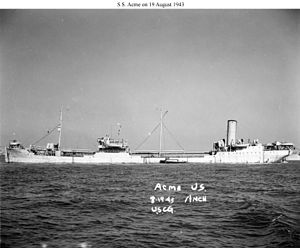The second USS Abarenda (IX-131) was a storage tanker, one of many miscellaneous-class Navy vessel crewed by the United States Coast Guard during World War II.
 SS Acme when she was inspected by the Twelfth Naval District in December 1917.
| |
| History | |
|---|---|
| Name | Acme |
| Namesake | Acme Oil Company[1][2] |
| Owner |
|
| Builder | Union Iron Works, San Francisco, California |
| Yard number | 125 |
| Laid down | 1916 |
| Launched | 29 April 1916 |
| Commissioned | 22 June 1916 |
| Identification |
|
| Fate | Requisitioned by the WSA 3 November 1943 |
 SS Acme at anchor, 19 August 1943, location unknown, shortly before being acquired by the USN.
| |
| History | |
| Name | Abarenda |
| Acquired | 26 February 1944 |
| Commissioned | 18 April 1944 |
| Decommissioned | 28 February 1946 |
| Renamed | 3 November 1943 |
| Stricken | 20 March 1946 |
| Identification |
|
| Fate | Scrapped at Shanghai 1948 |
| General characteristics | |
| Class and type | Emergency Fleet Corporation design 1047 tanker |
| Type | Floating storage tanker |
| Displacement | 19,410 long tons (19,720 t) |
| Length | 435 ft (133 m) |
| Beam | 56 ft (17 m) |
| Draft | 25 ft 6 in (7.77 m) |
| Installed power |
|
| Propulsion |
|
| Speed | 10.2 kn (18.9 km/h; 11.7 mph) |
| Complement | 10 officer 110 enlisted |
Design and construction
editAcme was an Emergency Fleet Corporation design 1047 tanker laid down by the Union Iron Works in San Francisco, in 1916, for the United States Shipping Board. She was launched 29 April 1916, and commissioned 22 June 1916.[2]
Acme was designed for transporting oil in bulk to Far Eastern ports that had been served by British ships before the outbreak of World War I. She, along with four more ships that were to follow her, had been designated "A" boats by the Marine Transportation Department.[2]
Service history
editWorld War I
editDuring World War I Acme filled in for British ship that had been commandeered by the British Admiralty. Her first voyage was to China. She would continue her San Francisco to China route for the next five years with only rare trips to New York for loads to Singapore via the Suez Canal. After the United States entered World War I, only Acme and two of her sister ships were available for Standard Transportation to use in the Pacific, this was mainly because on her return trips she would load coconut oil in the Philippines, which because of its 12 percent glycerin content made it a valuable war cargo.[2]
Post war service
editAcme started running a route from the "Texas-oil-coast" to "ports-north-of-Hatteras" in 1925. She changed owners in 1931 and 1935, but she didn't change names.[2]
World War II
editAcme was sailing for Corpus Christi, Texas, from New York, on 17 March 1942, about 1 nmi (1.9 km; 1.2 mi) west of Diamond Shoal Light, North Carolina, (35°03′N 75°12′W / 35.05°N 75.20°W) when she was damaged by a torpedo from U-124. Eleven of her crew were killed with the surviving 20 abandoning ship. They were rescued by USCGC Dione (WPC-108) and landed at Norfolk, Virginia, with Acme being towed to Lynnhaven Roads, Virginia, and later to Newport News, Virginia, for repairs. The War Shipping Administration (WSA) requisitioned her about a month later while she was still in dock.[2]
After repairs Acme served in transatlantic convoys, with deliveries of fuel to Guantanamo Bay Naval Base, on occasion.[2]
In September 1943, the WSA obtained full title to Acme when they traded six obsolete tankers for three new tankers.[2]
In anticipation of her acquisition by the Navy, Acme was renamed Abarenda on 3 November 1943 and simultaneously classified IX-131. She was purchased by the Navy on 26 February 1944 and commissioned on 18 April 1944.[3]
Abarenda was assigned to Service Squadron 10 as a floating storage tanker. She served at Manus Island in the Admiralty Islands until 20 February 1945 when she headed for the Philippines. The tanker arrived at Leyte on 13 March and, for the remainder of the War, dispensed fuel to the warships of the 3d/5th Fleet.[3]
Post war and decommissioning
editFollowing the end of World War II, Abarenda fueled the ships supporting the occupation forces in the Far East and continued that duty until 28 February 1946 at which time she was decommissioned in the Philippines. Returned to the WSA that day, she was berthed with that organization's reserve fleet at Subic Bay. Her name was struck from the Navy list on 20 March 1946 and she resumed the name Acme while in the WSA reserve fleet.[3]
Sold on 29 January 1948 to the Asia Development Corp., Shanghai, China, along with 15 other vessels, for scrapping, she was delivered to her purchaser on 3 March 1948.[3]
Notes
editReferences
editBooks
edit- Tarbell, Ida M. (1904). THE HISTORY OF THE STANDARD OIL COMPANY. New York: McClure, Phillips & C0. Retrieved 4 October 2016.
Online sources
edit- "Auke Visser's MOBIL Tankers & Tugs Site". Auke Visser. Retrieved 4 October 2016.
- "Abarenda II (IX-131)". Dictionary of American Naval Fighting Ships. Navy Department, Naval History & Heritage Command. 30 August 2016. Retrieved 5 October 2016. This article incorporates text from this source, which is in the public domain.
External links
edit- Photo gallery of USS Abarenda at NavSource Naval History